
Glycomics Market by Product (Enzymes, Instruments, Carbohydrates, Reagents & Chemicals), By Application (Drug Discovery & Development, Disease Diagnostics), By End-User (Academic Research Institutes, Pharmaceutical, and Biotechnology Companies, Clinical Laboratories), Geography (North America, Europe, APAC and RoW) - Global Forecast Up to 2026
- July, 2020
- Domain: Healthcare - Biotechnology
- Get Free 10% Customization in this Report
Glycomics is the comprehensive study of the structure of the glycomes, including genetic, physiologic, pathologic, and other aspects of the given cell or organism. Glycomics study is majorly used in various applications such as drug discovery, oncology, immunology, and others.
Research Methodology:
The glycomics market has been analyzed by utilizing the optimum combination of secondary sources and in-house methodology, along with an irreplaceable blend of primary insights. The real-time assessment of the market is an integral part of our market sizing and forecasting methodology. Our industry experts and panel of primary participants have helped in compiling relevant aspects with realistic parametric estimations for a comprehensive study. The participation share of different categories of primary participants is given below:

Glycomics market is expanding globally, and the factors driving this market are increased research activities on glycomics research, pharmaceutical and biotechnology companies have been investing in research and development, and development in the proteomics market. In addition, developing countries such as India and China are providing productive opportunities for vendors in this market. However, expensive tools are expected to hinder the glycomics market in the forecast period. The Glycomics Market is expected to reach from USD 1.08 billion in 2020 to USD 2.43 billion by 2026, at a CAGR of ~14.49%.
The Glycomics Market has segmented based on product, application, end-user, and region.
Based on Product:
- Enzymes
- Glycosidases & Neuramidases
- Glycosyltransferases & Sialyltransferases
- Other Enzymes
- Instruments
- Mass Spectrometry Instruments
- Chromatography Instruments
- Arrays
- Other Instruments
- Kits
- Glycan Release Kits
- Glycan Labeling Kits
- Glycan Purification Kits
- Other Kits
- Carbohydrates
- Oligosaccharides
- Monosaccharides
- Other Carbohydrates
- Reagents & Chemicals
Based on Application:
- Drug Discovery & Development
- Disease Diagnostics
- Other Applications
Based on End-user:
- Academic Research Institutes
- Pharmaceutical and Biotechnology Companies
- Clinical Laboratories
Based on Region:
- North America
- Europe
- APAC
- RoW
The Glycomics market based on the product is divided into enzymes, instruments, kits, carbohydrates, and reagents & chemicals. The enzyme segment has acquired the largest share in the glycomics market growth because the enzymes can be consumed, and the enzymes are largely used in the research and development and drug discovery processes.
In the application segment, the drug discovery and development is accounted to have the largest share in the glycomics market due to the increasing investments in research and development in the companies such as pharmaceutical and biotechnology along with increasing academic research institutes research activities in drug discovery.
Further, based on end-users, the market has been segmented into academic research institutes, pharmaceutical & biotechnology companies, and clinical laboratories. Academic and research institutes have acquired the largest share in the market due to the increased research and development activities in the drug discovery in academic research institutes.
Moreover, the glycomics market is segmented by four regions, including North America, Europe, Asia Pacific, and RoW. North America has been the major contributor in the glycomics market due to the increased funding and advanced technology used in the glycomics research and improvised R&D in pharmaceutical companies for drug discovery. Europe is also expected to take the second-largest share in the market growth.

Globally the Glycomics market is growing at CAGR of ~14.49% during the forecast period of 2020 -2026. The major factors driving the glycomics market are advancements in technology used in glycomics instrumentation, increasing demand for the proteomics market, and funding for the proteomics and glycomics research support in the market growth. Somehow, the expensive tools used in the analyses is a restraint to some extent in the glycomics market growth.
Globally the developing countries are providing opportunities for the market players; in addition, the rise in the biomarker discoveries and the emerging countries provide the opportunity to the glycomics market growth.
The key players active in the Glycomics Market covered in study are - Thermo Fisher Scientific, New England Biolabs, Shimadzu Corporation, Merck KGaA, Agilent Technologies, Asparia Glycomics S.L., Bio-Techne, Bruker Corporation, Danaher Corporation, Takara Bio, S-BIO subsidiary of Sumitomo Bakelite Co. Ltd., Waters Corporation, RayBiotech, Z Biotech, Chemily Glycoscience, Dextra Laboratories, Lectenz Bio, and Ludger Ltd.
This study will help the market players to understand the key market trends, market dynamics, and end-users pain-points. The qualitative and quantitative analysis in the study will enhance the user experience.
- The competitive analysis of the major players enables users to understand the dynamic strategies such as product innovation, partnerships, merger & acquisitions and joint ventures of the key players
- This report also provides portfolio analysis, capability analysis of the leading players
- The report will also help the research organization of Glycomics Market to support their drug discovery and development activities
- Quantitative analysis of the market enables users to understand the actual facts of the market across four major regions
- Executive Summary
- Industry Outlook
- Industry Overview
- Industry Trends
- Market Snapshot
- Market Definition
- Market Outlook
- PEST Analysis
- Porter Five Forces
- Related Markets
- Market characteristics
- Market Evolution
- Market Trends and Impact
- Advantages/Disadvantages of Market
- Regulatory Impact
- Market Offerings
- Market Segmentation
- Market Dynamics
- Drivers
- Restraints
- Opportunities
- DRO - Impact Analysis
- Product: Market Size & Analysis
- Overview
- Enzymes
- Glycosidases & Neuramidases
- Glycosyltransferases & Sialytransferases
- Other Enzymes
- Instruments
- Mass Spectrometry Instruments
- Chromatography Instruments
- Arrays
- Other Instruments (electrophoresis instruments, NMR instruments, and HPLC columns)
- Kits
- Glycan Releasing Kits
- Glycan Labelling Kits
- Glycan Purification Kits
- Other Kits
- Carbohydrates
- Oligosaccharides
- Monosaccharides
- Other Carbohydrates
- Reagents & Chemicals
- Application: Market Size & Analysis
- Overview
- Drug Discovery & Development
- Disease Diagnostics
- Other Applications
- End User: Market Size & Analysis
- Overview
- Academic Research Institutes
- Pharmaceutical and Biotechnology Companies
- Clinical Laboratories
- Geography: Market Size & Analysis
- Overview
- North America
- Europe
- Asia Pacific
- Rest of the World
- Competitive Landscape
- Competitor Comparison Analysis
- Market Developments
- Mergers and Acquisitions, Legal, Awards, Partnerships
- Product Launches and execution
- Vendor Profiles
- Thermo Fisher Scientific, Inc.
- Overview
- Product Offerings
- Geographic Revenue
- Business Units
- Developments
- Business Strategy
- Merck KGaA
- Overview
- Product Offerings
- Geographic Revenue
- Business Units
- Developments
- Business Strategy
- Agilent Technologies
- Overview
- Product Offerings
- Geographic Revenue
- Business Units
- Developments
- Business Strategy
- Bruker
- Overview
- Product Offerings
- Geographic Revenue
- Business Units
- Developments
- Business Strategy
- New England Biolabs
- Overview
- Product Offerings
- Geographic Revenue
- Business Units
- Developments
- Business Strategy
- Danaher
- Overview
- Product Offerings
- Geographic Revenue
- Business Units
- Developments
- Business Strategy
- Shimadzu Corporation
- Overview
- Product Offerings
- Geographic Revenue
- Business Units
- Developments
- Business Strategy
- Takara Bio, Inc.
- Overview
- Product Offerings
- Geographic Revenue
- Business Units
- Developments
- Business Strategy
- Waters Corporation
- Overview
- Product Offerings
- Geographic Revenue
- Business Units
- Developments
- Business Strategy
- Thermo Fisher Scientific, Inc.
- Companies to Watch
- Raybiotech, Inc.
- Overview
- Market
- Business Strategy
- Z Biotech, Llc.
- Overview
- Market
- Business Strategy
- Chemily Glycoscience
- Overview
- Market
- Business Strategy
- Dextra Laboratories Ltd.
- Overview
- Market
- Business Strategy
- Lectenz Bio
- Overview
- Market
- Business Strategy
- Ludger Ltd.
- Overview
- Market
- Business Strategy
- Valiant Co., Ltd.
- Overview
- Market
- Business Strategy
- Sanyo Fine Co., Ltd.
- Overview
- Market
- Business Strategy
- Raybiotech, Inc.
- Analyst Opinion
- Annexure
- Report Scope
- Market Definitions
- Research Methodology
- Data Collation and In-house Estimation
- Market Triangulation
- Forecasting
- Report Assumptions
- Declarations
- Stakeholders
- Abbreviations
Research Framework
Infoholic research works on a holistic 360° approach in order to deliver high quality, validated and reliable information in our market reports. The Market estimation and forecasting involves following steps:
- Data Collation (Primary & Secondary)
- In-house Estimation (Based on proprietary data bases and Models)
- Market Triangulation
- Forecasting

Market related information is congregated from both primary and secondary sources.
Primary sources
involved participants from all global stakeholders such as Solution providers, service providers, Industry associations, thought leaders etc. across levels such as CXOs, VPs and managers. Plus, our in-house industry experts having decades of industry experience contribute their consulting and advisory services.
Secondary sources
include public sources such as regulatory frameworks, government IT spending, government demographic indicators, industry association statistics, and company publications along with paid sources such as Factiva, OneSource, Bloomberg among others.
